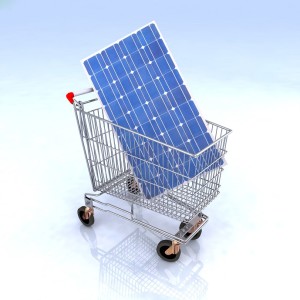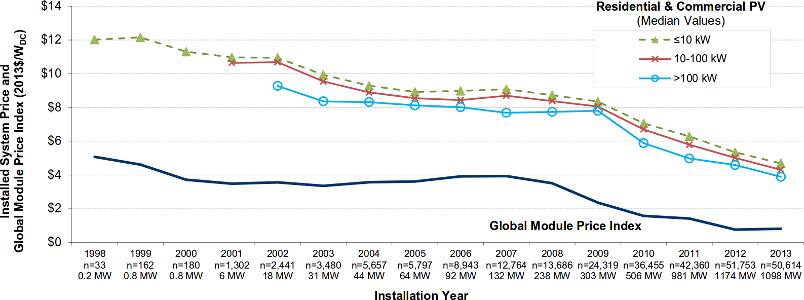Demystifying solar panel cost per watt
 Many homeowners, when they start their solar journey, hit the same roadblock early on: determining the cost of solar panels. They hear about all sorts of benefits of solar power, such as lower utility bills, abundant clean electricity and vastly reduced greenhouse gas emissions. But as soon as they take the next step and seriously look into the financial viability of going solar, the confusion begins. Finding a simple and unbiased answer to even the most basic cost-related question, such as "How much will it cost me to have these panels installed?" can be frustratingly difficult.
Many homeowners, when they start their solar journey, hit the same roadblock early on: determining the cost of solar panels. They hear about all sorts of benefits of solar power, such as lower utility bills, abundant clean electricity and vastly reduced greenhouse gas emissions. But as soon as they take the next step and seriously look into the financial viability of going solar, the confusion begins. Finding a simple and unbiased answer to even the most basic cost-related question, such as "How much will it cost me to have these panels installed?" can be frustratingly difficult.But have no fear! We'll first cover the concept of cost per watt and then introduce you to another cost metric (lovingly called the LCOE - levelized cost of energy) that is crucial in making sense of solar economics.
Cost per watt explained
The total cost of installation includes equipment, labor and "soft costs." Solar equipment prices have been going down significantly in the last few years, but other cost items remain stubbornly high. The term "soft costs" is a blanket category that includes permitting fees, marketing expenses, taxes and other miscellaneous costs.
The cost per watt metric is nothing but a handy way to "normalize" the total cost of installation. For example, if the cost of installation for a 5 kW (i.e., 5,000 watt) solar pv system is $20,000, then the cost per watt of this system is $20,000 divided by 5,000 watts: $4 per watt. So if you hear someone mention that their "solar panel cost per watt" is $4 per watt, they probably mean the whole cost of installation, not just the panels. Also, you may see some installers give the cost per watt using the following notation: $ 4/Wp. The "Wp" stands for watt-peak, another way to indicate the installed capacity of a solar pv system.
Let's put this concept to work right away. Which system is more expensive? A 5kW system that costs $20,000, or a 6 kW system that costs $24,000? Trick question! They cost the same when we use the cost per watt metric: both systems cost $4 per watt.
We should mention that the federal investment tax credit (ITC) available to U.S. homeowners, at the full amount, until 31 December 2019, should be factored into these calculations. As this tax credit effectively means a 30% reduction in the net cost of installation, it also reduces the cost per watt by the same amount (so that $4/W effectively becomes $2.8/W once the ITC is received). After 2019, the ITC will be gradually phased out over three years until it is completely eliminated after 2022.
Latest cost per watt figures
The latest cost figures reported by NREL indicate that the average price of a residential solar energy system (in the range of 2.5kW to 10kW capacity) was between $4.15 and $4.50 per watt in 2014 without any incentives. This figure is based on data reported from Arizona, California, Massachusetts, and New York.

Evolution of solar panel cost per watt: 1998-2013 (source: NREL)
The $4/W range today represents a vast reduction compared to a few years ago: as can be seen in the graph above, all-in costs were in the $8-10/W range up until 2009. The reduction in solar panel equipment prices (as shown in the bottom curve in the graph) definitely helped with this overall trend. In fact, today, the main cost challenge is not about the solar panels themselves, but with the remaining cost items.
Cost per watt figures in the U.S. contrast sharply with other countries that are further along in solar adoption. The latest cost per watt figures (for a complete solar PV installation) in Germany are around $2/W. While this raises a lot of questions about why the U.S. is so far from Germany's cost levels, it also gives us hope that lower prices can be achieved.
Where can you find cost per watt information?
Because the cost per watt varies from country to country and from state to state, it's always a good idea to find out the average cost of installation in your area. It used to be quite difficult to get this kind of information, but a recent initiative has made it much simpler: the Open PV project. This NREL initiative collects information from installers and homeowners across the U.S. and provides very useful insights. For example, in 2014, the average installation cost for systems under 10 kW was $4.8/W in California and $3.6/W in Texas. As you can see, there can be significant differences between the states, so the $4/W average figure may not apply to your case. Therefore, we strongly recommend you to look up the latest average cost figures in your own state before getting your quotes.
What about maintenance costs?
The cost per watt metric is a great start to assessing the financial aspects of solar ownership, but we have a bit more work before we can safely conclude the cost discussion. If you are thinking of owning the solar pv system (as opposed to leasing it), then your total cost of ownership will also include maintenance and the eventual replacement cost for the inverter. The solar panels generally come with a 20-25 year warranty, and with no moving parts, they should be low maintenance, consisting of an occasional cleaning. However, the inverter will need to be replaced at around the 7-10 year mark of the lifetime of your system. A ballpark figure for the inverter replacement + maintenance cost is 10-20% of the installation cost. Thus, if you are considering a $20K system, you should factor in another $2000 - $4000 in future costs. Generally speaking, this extra cost is not included in the cost per watt estimates. So wouldn't it be nice to have another cost metric that captures the lifecycle cost?
LCOE: Not a pretty name, but very useful indeed!
The levelized cost of energy is essentially the entire operating cost of your solar pv system. It includes the initial installation cost, cost of financing, cost of replacement inverter and maintenance and most importantly, it's based on the expected energy generation specific to your location. We say this often, when it comes to solar energy, it's all about location, location, location. In this case, the higher the insolation levels, the lower the levelized cost will be (all other variables remaining the same). Let's use the following case to illustrate the importance of levelized cost. Bob is a homeowner in Portland, OR and Sue is a homeowner in Houston, TX. Both Bob and Sue received quotes for a 5 kW solar PV system for their homes (with exactly the same solar PV equipment). Both quotes come with a price tag of $20K (so $4 per watt when it comes to the cost per watt metric). The only difference is the location: Sue is luckier as a result of her more southerly location. Due to higher insolation levels, she will produce more solar electricity over the lifetime of her panels, and as a consequence, the levelized cost of her solar PV system will be lower.
Levelized cost is such an important metric that it is in fact a key factor in deciding whether solar energy will save you money: to answer that question, you need to compare the LCOE of solar to the retail electricity rate from your utility. If the solar levelized cost is less than the utility rate, you should definitely consider solar energy (for example, if the LCOE of solar where you live is $0.14/kWh and your utility rate is $0.17/kWh, solar energy will save you money over the lifetime of your panels). For more information on the levelized cost of energy, we've written another article that can be helpful. And to see what the average levelized cost of solar is by state, you can refer to our interactive grid parity map.
Summing it all up: learn your cost per watt, but don't stop there
Understanding the economics of solar is key to making the best decision for your home. Both the cost per watt and the levelized cost are very useful metrics in this regard. We know that all this information may be a bit too much to digest if you're just starting on your solar adventure. But we are here to help. You can head to WhatNextNow Solar Discover to see the impact of these cost metrics for your own home. Don't worry about any complicated calculations, we've already done the heavy lifting for you. Just enter your address and begin your solar journey!
Sources:
- NREL, Photovoltaic System Pricing Trends, Feldman et al., 2014
- NREL, Benchmarking Non-HardwareBalance-of-System (Soft) Costs for U.S. Photovoltaic Systems, Friedman et al., 2013